Blog Category: MEAN Stack Development
Why MERN Stack Development Is A Go-To Stack For Developers?

MERN stack development is similar to MERN, but the only difference is the usage of Angular for front-end web application development instead of React. The ReactJS component of the MERN stack allows the application’s UI to be highly interactive and dynamic. MERN is among the best combinations of full-stack technology that has made its mark in web application development.
Both are just as good, and being a top web development company in the USA, we have experience in both stack development. Our implementation methodology and design thinking to MERN development can offer you a fully functional website with appealing UI designs to entice users. The time and effort spent on MERN stack development can carry your project to another level. You can also hire a MERN stack developer from us for your project development requirements smoothly from our experienced talent pool.
About MERN Stack
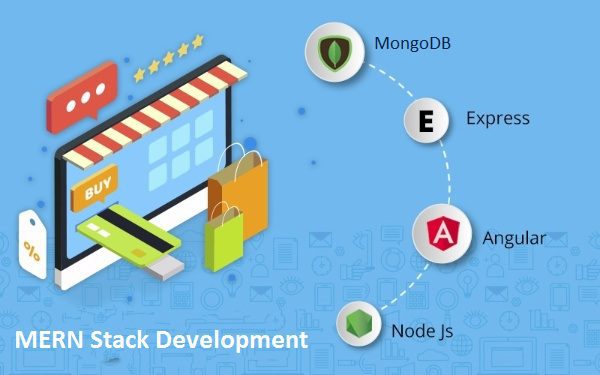
MERN is a JavaScript stack with four efficient open-source components; they are
- MongoDB: A non-relational cross-platform functioning database for storing JSON files.
- Express: A backend, Node.js framework for developing REST API and web applications
- React: A library that helps in rapid code development and carries out better than Angular JS.
- Node.js: A backend environment running modules like Express asynchronously
These components take care of the most critical assessments and also the redundancy of particular tasks. They are widely used in the SPA – Single Page Application development.
MERN stack offers businesses and enterprises the required performance, agility, and intelligence to drive their business ahead. Always there is a vast, never-ending demand for performance and interactivity levels by web users. JavaScript, the central element of several technologies, allows the developers to create dynamic websites suitable for desktop and mobile applications.
The demand for MERN developers is increasing, and the MERN stack is prime in the life of a software developer due to its benefits.
- Pure JavaScript code which eliminates context switching
- JavaScript stack makes interfacing various programming languages easy and straightforward
- Developers need to work only with JSON and JavaScript
- Builds highly efficient web applications.
- React is easy to learn and build as it is template-free.
- React helps to build conditional or redundant DOM elements with JavaScript
- React is isomorphic and can function on the browser and server.
- Highly useful for SEO purposes.
MEAN v/s MERN stack
The main distinction between the MEAN & MERN stack is the React JS library and Angular JS framework, which is customary for its MVC architecture. However, you may not need MVC architecture for all kinds of web application development.
Certain web applications need an abstraction on the UI layer to improve component code rendering. React JS library happens to meet this requirement.
When it comes to performance, Angular JS offers better code abstraction and manages files systematically. React JS can develop code swiftly, and being a library, it can perform better than Angular JS relatively.
MERN stack development is apt for the quick building of smaller applications when compared to the MEAN stack.
The trends, diverse requirements make it challenging to choose the ideal framework. Stack technologies always help you with the aptest stack for your business requirements.
Why should you hire MERN stack developers from us?
We, Tops Infosolutions, our expert MERN stack Development Company, among other web development services. Our MERN stack developers are experienced in e-commerce, the fashion and apparel industry, music collaboration, social networking, arbitrage, the local NEWS sector, and many others. We strive to offer the finest solutions possible for every business.
Our MERN stack development services comprise of
- Enterprise-web-application-development for large scale businesses
- Web and mobile application development with highly interactive solutions, gripping user experience, and multi-device compatibility
- Custom web and mobile application development
- Migration of business applications and platforms to the MERN stack framework.
- Complete CMS development services with MERN stack to support and handle data systematically.
- Competing pricing for Custom eCommerce development services.
The hiring process for our MERN stack developers for their web or mobile development needs is convenient and straightforward.
- Pay-as-you-go model
- Various options to choose
- Quick turn-around time
- Total visibility and control over your project
- No additional setup is required
- Shorter starting cycle
- Round the clock support
We are an expert web Development Company in the USA with complete know-how in different stack development applications. To hire seasoned MERN developers for collaboration or a free quote, dial +1 408-400-3737
Read More Articles:
What MEAN Stack Development Has To Offer For Your Next Web Development Project?
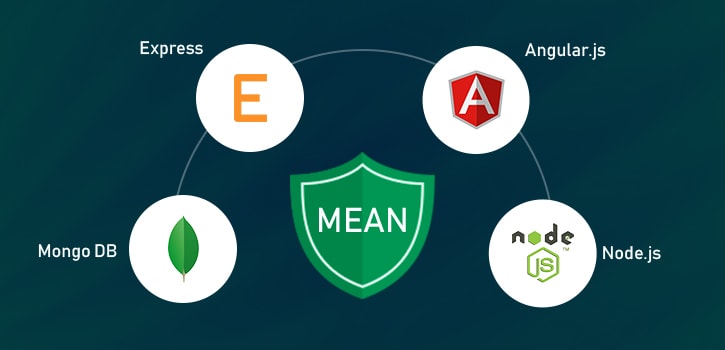
To develop a robust backend, an efficient set of tools mainly designed to cut down the development time and streamline resources is essential. But, present technology poses several software stacks like LAMP, MERN, Ruby on Rails, and more. This profusion has made the stack field jam-packed.
That’s a significant reason why many developers are going for a combination of technologies to achieve superior and rapid results for mobile and web app development. MEAN stack is the chief example of combined technology. In this article, we’ll see how MEAN stack development is advantageous to the developer and the organization.
Contribution of each MEAN component
MongoDB
The critical role of MongoDB in the MEAN stack is the data storage of the application. There is no need for translation when the object moves from the application to the database and vice-versa, since both the database and the application use unilanguage, JavaScript.
MongoDB is renowned for its scalability in both storage and performance. It can guarantee fail-safe management of enormous volumes of data. It also facilitates adding fields to the database without the need to load the whole table again.
Express.js
Express.js forms MEAN stack’s backend and it is responsible for handling the communications between the database and the front end. It makes sure that the data transfer is smooth and without time delay to the end-user. It follows a minimalist approach, and hence all the processes are handled efficiently. Although it is minimalistic, it is feature-filled. Express.js makes you worry less about overwriting variables as it prevents you from redefining a variable again that you had written earlier. It saves much time and money.
AngularJS
AngularJS is a trendy JavaScript front-end framework that is used to build the user-end of the application. It ensures a smooth flow of data between the front end, backend, and database since they are developed based on JavaScript.
Angular JS is a perfect front-end framework for developers as it has easy-to-use templates and more excellent performance levels. Furthermore, you can develop both mobile and desktop apps simultaneously.
Node.js
In MEAN stack development, Node.js performs as the backbone. Express.js is developed explicitly to work over Node.js. Besides, Angular JS also links to Node.js without a glitch to enable fast data serving.
Node.js makes it simpler for developers to deploy the MongoDB database to the cloud because of its inbuilt webserver. Node.js is highly scalable, and it can support numerous connections simultaneously. It is more attuned to work with low-resource requests than high-resource requests.
Advantages of MEAN stack development technology
- Easy isomorphic coding – MEAN stack makes easy code transfer written in one framework to another. Many MEAN stack development companies are discovering new technologies that can enhance websites and applications’ developmental perfection in recent days.
- Greater flexibility – It is so flexible that the developer can test the application quickly on a cloud platform once the app development process is completed. It lets you develop, test, and launch the application without any troubles. Furthermore, you can add more information once a field is added to the form. MongoDB offers end-to-end support alongside automatic replication.
- Cost-effective -MEAN stack development needs a comparatively less number of developers. Unlike the LAMP stack, which requires developers proficient in technologies like MySQL, JavaScript, and PHP, the MEAN Stack is a highly cost-effective app development method.
- High speed and reusability – MEAN stack development deliver speedy and reusable code due to Node.js’s non-blocking architecture. Additionally, using Angular JS, an open-source JavaScript framework, provides Reusability, Testability, and Maintenance.
- Cloud compatibility – MEAN stack makes use of public repositories and libraries for the development process. The overall cost for development is also minimal when using this technology stack. Over and above that, MongoDB utilizes the app’s cloud functionalities, thus decreasing the cost of disk space.
- Open-source platform – You can do updates in the MEAN stack frequently as its components are exclusively open-source.
- Unilanguage development – using MEAN stack development is advantageous because the entire coding for development happens in JavaScript. It takes account of development from client-side to server-side.
- Simple to learn – MEAN stack has a shorter learning curve and easy for anyone – front-end developers or backend developers – to learn. It is easy to comprehend and implement during the development process.
Quality user interfaces- MEAN supports Model view controller (MVC) architecture due to which it delivers excellent user interfaces. - Huge library – Node.js has a vast library with a wide variety of JavaScript modules, which makes the web application development process with Node.js stress-free.
- Flexibility with MongoDB – MongoDB offers a flexible JSON document structure that can be utilized for data representation. It is apt for big sized projects.
- JSON usage – JSON is used almost everywhere in the MEAN stack. Both Angular and Node.js provide JSON. MongoDB, a database framework, also stores the entire data in JSON format. Also, Express JS makes use of JSON. Overall, MEAN uses JSON all over the development process to facilitate smooth data flow without any reformatting of various layers.
<h3
Developers at Tops Infosolutions are incomparable when it comes to MEAN stack development technology and their own years of experience. If you wish to build any application or website with MEAN stack technology or hire MEAN stack developers, get in touch with our experts at Tops.
MEAN stack technology keeps on advancing day by day. Many leading web and mobile app development companies are using MEAN stack technologies at length to provide trailblazing web and mobile applications for the users.
When And Why Should Companies Consider Hiring MEAN Stack Developers?

A MEAN stack Developer
A MEAN stack developer is a full-stack developer who is proficient in Mongo DB, Express JS, Angular, and Node JS in addition to other basic programming language requirements. They can efficiently handle both front end and backend end development.
They should be able to visualize how the website or application that is to be developed will look like from the user’s end view. Nowadays, many companies opt to hire MEAN stack developers and other full-stack developers as it is cost-saving. There, it does not require hiring each developer specialized in each technology. Here are the various scenarios that call for hiring MEAN stack developers and the benefits it offers.
Role of a Full-Stack Developer
A full-stack developer is capable of performing the following tasks efficiently:
- Handling several projects and performing client coordination
- Producing front-end codes in HTML or JavaScript
- Writing simple backend codes in Python, Php, or Rub
- Studying, building, and debugging database related queries
- Keeping a check on web applications and UI performance
- Developing test codes for validation of the application
- Testing and resolving bugs present in the web application
When do you need to hire a MEAN stack developer?

When your company’s ultimate goal is to validate the notion by developing a minimum viable product, then a full stack developer is the best bet. They can understand the idea and transform it into an entirely functional prototype.
- When you require Product Managers, you can go with Full-stack developers because they can clearly understand the business requirement and are mindful of their abilities to tackle various scenarios with their extensive skill and expertise skillfully.
- When budget is a constraint, it becomes challenging to deploy various professionals for each development process layer. Thus, full-stack developers can do it all. It is a cost-effective solution.
Significant Benefits of Hiring a MEAN stack Developer
There are numerous benefits in hiring MEAN stack developers to manage projects from ideation to launch and past them.
- Being accomplished web app developers, they can manage the entire stack from the ground up. Investing in full-stack developers can fetch you good returns.
- They are versatile and excel in both front and backend development. Thus your app appearance, interactivity of a site in a browser, codes that link a website to the CMS, etc., are all taken care of.
- The experience and in-depth knowledge they possess are very much beneficial to the performance and market response of projects.
- A MEAN stack developer knows the bigger picture and can help you with the entire structural design, and give valuable inputs when required. In addition to development, it can also help in optimizing the current system.
- They do the all-inclusive work, i.e., in addition to managing the project, adding enhanced features, they can also represent your company and the product as and when needed. They can
- switch quickly from one operation to the other, which aids in streamlining the processes and speed up the development.
- They can identify and troubleshoot issues in every aspect of website development. Implementing long-term solutions are essential for the best functioning of your website or application.
- They are a budget-friendly investment! You can build a fantastic website even with a shoestring budget with full-stack development services. Single-handedly they manage everything, and this saves you a lot of money.
- They are responsible for MVP development from beginning to end. So, having a full stack developer in place is excellent for maintaining the design project’s quality assurance. In addition to handling the MVP development, they know the ways to control both the server-side and client-side of the application.
- Companies seek MEAN stack development services that also covers the management aspects of project development. It can be handled by MEAN stack developers much efficiently than other individual developers.
- Speedy development is what all companies expect as no one wishes to enter the market late. Full-stack developers know the varied range of technologies, techniques, and tools that help them complete the project undertaken faster. Discussion and collaboration with the team and commencing won’t take much time.
Wrapping it up
Looking for the best MEAN stack developers for working on your project might be a challenging job. It is best to be clear about the project requirements and the engagement model, like in-house or offshore. So before you begin hiring, you need to assess the skills and experience to be sure that they are proficient within their technology stack.
We are a custom software development company in the USA and we make hiring developers an easy task for many companies. All you have to do is send us your requirement, and we will match the right developer based on your project need. You can also select from varied CVs and discuss with them before hiring. We will assist you with the entire process and also offer you the best hiring model. For more details, reach us by calling at +1 408-400-3737 or drop an email at: contact@topsinfosolutions.com
Know The Things To Consider Before Hiring A Mean Stack Developer
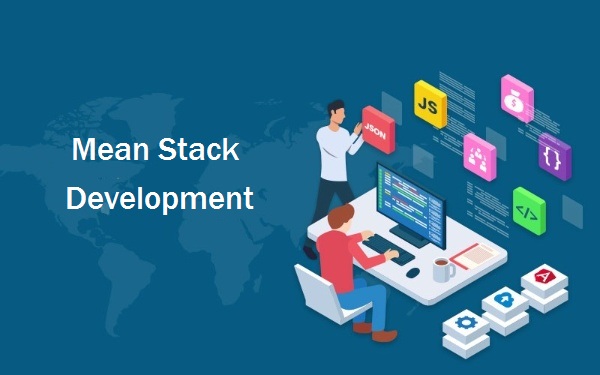
Nowadays, learning the fundamentals of the programming languages or frameworks for the developers can be chosen in less time. It can be achieved by a simple brainstorming session with the team and analyzing the technologies available in the market; the budget allocated, and time duration. But, what it lacks is the precise requirement of the client’s need.
Also, the usual approach is by bustling through tutorials and demo codes. The developer may be able to pull off implementing the layers as per the requirement for that specific project. But there’s a huge difference when it comes to mastering the language.
If you are looking for a full-fledged web application, it is best to go for MEAN stack development. A MEAN stack developer is a type of full-stack JavaScript developer who is responsible for complete software development activities. It includes designing, development, integration, and testing. Not only being familiar with the technologies, but he would also be versatile in
-
MongoDB
A cross-platform non-relational database for storing JSON files.
-
Express
A backend, Node.js framework for building web applications and REST API
-
Angular
Open-source front-end framework for creating the display portion of any Single Page Application (SPA)
-
Node.js
A backend environment running modules as Express with an asynchronous model
Certain Skills that you need to look out if you want to hire MEAN stack developers are:
- HTML/CSS
- JavaScript languages
- Back end Languages
- HTTP/HTTPS and REST
- Databases/Web Storage
- Web Architecture
- Source control
- Text editors and Database management
- IDE’s Integrated Development Environment
- Networking and testing
- Cross-Platform Software
- Encryption and Cryptography
- SDLC Software development life cycle
- Data Maintenance and quality check
- Project planning, profiling, and upgrading
The following activities are carried out by a full- stack developer:
- Interpreting user requirements into an inclusive architecture
- Client coordination to understand the exact requirement
- Executing the system
- Writing flawless backend code
- Writing augmented front-end code
- Working with various databases and storage
- Understanding of programming modules and design architecture methodologies
- Understanding, building and debugging the database requests
- Creating test code
- Monitoring web application performance
- Testing infrastructure and troubleshooting the application
There are likenesses in architectural design and configurations through various stacks like MERN and LAMP. MEAN Stack Application Development sees a rising trend in practice. Many top companies and are reaching out for MEAN stack development either exclusively or partially. Some of them are Facebook, Airbnb, Yahoo, Whatsapp, and PayPal. MEAN stack helps their business to advance in performance.
Why should you hire MEAN stack developers from us?
We, Tops Infosolutions, are a specialized MEAN stack development company, among other development services. We have a gene pool of dedicated MEAN stack developers. They have experience in e-commerce, music collaboration, fashion and apparel industry, the local NEWS sector, social networking, arbitrage, and many more. They are out-of-the-box thinkers and can furnish the best solutions possible for your business.
Clients have the option of hiring our MEAN stack developers for their web or mobile app development requirements. Our process is simple and convenient.
- Pay-as-you-go model
- Round the clock support
- Quick turn-around
- Complete control over your project
- Needless to worry about setup
- Choice to select
- Shorter starting cycle
To hire them for collaborating with your projects, for more information and a free quote, dial: +1 408-400-3737
An Ultimate Guide To Hiring The Dedicated MEAN Stack Developers

We all need a gene pool of dedicated MEAN stack developers with significant experience in developing MEAN stack and full stack projects for various Businesses like e-commerce, music collaboration, fashion and apparel industry, local NEWS sector, social networking, arbitrage, and many more. Main highlight is that they are out-of-the-box thinkers and can furnish the best possible solutions and results. Clients have the option of hiring best talent for their web or mobile development requirements.
Before we come to hiring full-stack web developers, let’s see why this stack development is gaining importance. MEAN stack development is currently in demand due to its robustness and the ability to develop complex web applications effortlessly and quickly. MEAN is a combined Javascript framework of MongoDB, Express.JS, Angular, and Node.JS. Also, utilizing a full stack can tremendously improve the functionality of your mobile or web app development.
Many top companies and brands are going for MEAN stack development either wholly or partially. Some of the stack technology users are Facebook, Airbnb, Whatsapp, Yahoo, PayPal and many more. MEAN stack makes their Business strive better in terms of performance, and developers prefer using this stacking technology due to the below-mentioned advantages.
Advantages Of MEAN Stack Development
- Single language code, Javascript, for both server side and client side communications
- Open source framework, readily available, access to public repositories and libraries
- Backs MVC architecture, enhances productivity and needless to deal with a variety of programming languages.
- A universal programming language, JavaScript, eases the work for any new developer who enters during mid-work schedule
- Test your app even during the development process, and host it on the cloud
- Meet deadlines easily with MEAN because of Node.js’s excellent compilation of module libraries
Why Is It Best To Hire Dedicated Mean Stack Or Full Stack Web Developers?
Most clients find it convenient to proceed with hired resources and get the job done. Some of the benefits of hiring a MEAN stack or a full stack web developer are:
Pay as you go model
it is the most convenient model for both clients and the company. You get your job done, and we get our payment. This model reduces the bulk investment cost for the client at initial stage.
Round the clock support
our developers and support team are available around the clock to meet your queries and share updates. So, time zones do not matter much.
Quick turn around time
Get your entire project done within the fastest possible estimated time
Complete control over your project
You are given access to your project even during the development phase so that you can log on to know the status
Needless to worry about setup
We take care of the entire hardware and software required for your project development
Choice to select
You have the liberty to decide from a wide range of expert IT resources with diverse skillset
Shorter starting cycle
No project requires considerable workforce allocation in the initial stage. You can start up small and increase the resources on the go according to the developmental needs. It is more effective, economical, and requires minimal effort.
The process of hiring with us is simple. All you have to do is send us your requirement to contact@topsinfosolutions.com hire a dedicated MEAN Stack developers along with your idea. We brainstorm and analyze your requirements. You can evaluate our quote, hire dedicated developers, assign work to them, and get regular updates on the work process.
Feel free to reach us to hire dedicated MEAN Stack Developers or Full Stack Web Developers. Dial +1 408-400-3737 or +91-7575000269
Read More Articles:
- How Does MERN Stack Development Help In Building Web And Mobile Applications?
- An Ultimate Guide To Hiring The Dedicated MEAN Stack Developers
- Top Skills to Identify Before Hiring the Best Full Stack Developer
- Why MERN Stack Development Is A Go-To Stack For Developers?
- How Will MEAN Stack Development Add Value to Your Business?
Myths About MEAN Stack Websites Not Being SEO-Friendly


MEAN Stack is a collection of technologies based on JavaScript used for the purpose of developing websites and web-based applications. It is an excellent option to create robust and fast applications in the industry that is surrounded by cut-throat competition.
In the past few years, MEAN stack has become a feasible alternative to create high-performance and dynamic websites and applications. It has garnered the interest of many technology firms that have invested in the JavaScript domain. This is because it offers a myriad of advantages, including lower utilization of human resources, cost-reduction, seamless operation, re-usability of software components, and more.
Despite the benefits, there is some confusion among people regarding whether to choose MEAN Stack for their websites. Read on to learn what this concern is all about.
Misconceptions About MEAN Stack Development & SEO
I often get clients who are skeptical about MEAN stack development services because of the widespread belief that the result is not SEO-friendly. They are of the opinion that although the technology helps to create user-friendly and robust websites, it is difficult to get the site recognized by search engines such as Google, and even more challenging to get it ranked in the Search Engine Result Pages.
To understand why people believe it is difficult to integrate SEO practices with a MEAN website, it is essential to get acquainted with its architecture.
MEAN Stack Components & Architecture
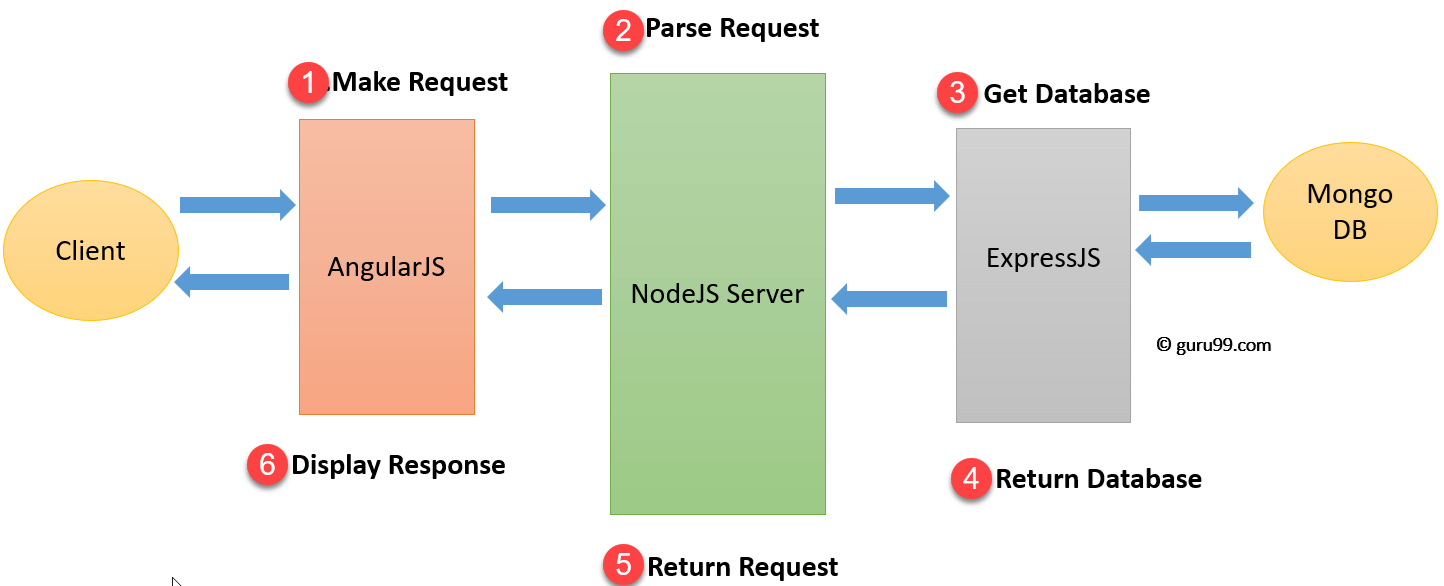

The different elements of Mean Stack Architecture and their primary function are as follows:
- Angular JS – Accepts requests from the users and displays results
- NodeJS – Manages the Client and Server Requests
- Express JS – Makes requests to the Database and returns the responses
- MongoDB – Stores the data and retrieves it whenever required
Problems with JavaScript & SEO
Since MEAN stack has a JavaScript framework, the pages we want indexing are rendered in JS, making the entire process of SEO a little challenging. This is because although the site looks great and runs fast, search engines such as Google still won’t be able to crawl the content. To put it clearly, for a search engine to understand MEAN websites, they have to render or execute JavaScript.
In addition to this, there are no specific general JS coding guidelines that can be used to create websites and applications.
To summarize:
Crawl, Index, Rank – 3 Problems in MEAN Stack SEO


So, Is SEO Possible for MEAN Websites?
After hearing about such challenges that surround MEAN stack development, many people think that it could kill their SEO.
However, I believe that such notions are the result of a lack of clarity and understanding on the part of the users. It helps to remember that part of digital life is to work with what you have. And what you have in the form of a MEAN website is already loved by the end-users. Thus, it is only wise that we take a better approach that yields excellent results, making the entire process of SEO a worthy investment.
To put it simply, the approach to SEO for a MEAN website is a little different than HTML-based bites. However, SEO professionals have to think outside the box to come up with ways that can help search engines understand JavaScript. Although it requires a different approach to be taken, the task is not as impossible or difficult as it may seem at first glance. To answer the question, yes, SEO can be implemented for MEAN websites.
TOPS Offers Excellent MEAN Stack Development Services
TOPS Infosolutions is a leading MEAN Stack development company offering reliable and prompt services. We have tech expertise and skills to help you create a website or application according to your requirements.
All you need to do is get in touch with us to discuss your project, so we can determine what needs to be done.
You Might Also Want to Read:
How Can MEAN Stack Development Help Your Business?
Building Modern and Scalable Enterprise Apps with MEAN Stack
Secure Your Web App Against Modern Web Threats Using MEAN Stack


MEAN stack brings full stack development under purview of a single programming language, JavaScript. Alongside bringing the best of the frontend and backend technologies under a single basket, MEAN stack inherits security vulnerabilities each of these technologies are susceptible to. Some of the security threats augment when these technologies play together inside the framework. If those vulnerabilities are not subsided by the MEAN stack developers at the time of writing code, they will put the entire organization using those applications at jeopardy.
For example, MongoDB is a NoSQL database and an integral part of the MEAN stack. A common myth is NoSQL means no injections. In reality, MongoDB has a concept of query selector operators. These operators start with a dollar sign: $gt means greater than, $ne means not equal to, $not for negation, etc. If an attacker can inject these queries selector operators into the query, he can alter the logic of that query.
Here the presence of Express.js in MEAN stack makes the situation worse; it acts as a catalyst to NoSQL Injections. When Express sees nested URL encoded parameters in an input, it’s going to automatically parse them. This allows a person to inject a query operator into hid statement and alter the logic of this operation. And that’s only a part of the problem with MongoDB and there are three more technologies with their own share of risks and vulnerabilities.
Let’s take a look at the all the technologies inside MEAN stack and what are the potential security risks they can expose your application to.
1. MongoDB
As I said, MongoDB is immune to SQL injections but not every type of injections. In fact, MongoDB are more susceptible to something called Query Selector Injections or NoSQL Injections than MySQL is to SQL injections. The JSON documents with some neat, little tricks can be altered to achieve some malicious results. This as I mentioned above involve built-in logic operators to alter queries.
Another problem with MongoDB is this that it doesn’t force authentication that means that five year old hacker living next door can query the database with little to no difficulty. The icing on the cake is MongoDB’s optional HTTP and REST interface, which not only puts the database and the sensitive information inside it on the public domain but also the underlying file system.
To make sure, your database is not accessible to anybody make sure you disable HTTP and REST interface. You can configure /etc/mongodb.conf file’s bind_ip, auth,httpinterface, and rest options to contain access to the database and, thus, secure the MongoDB instance as demonstrated below.


Ransom-wares targeting the insecure default conf file on these servers exploited more than forty thousand instances of MongoDB by January 2017.
2. Node
Node.js facilitates the development of web applications with broad backend capabilities:server and networking capabilities. It makes way for real-time bidirectional communications back and forth from server and client. Node.js is a standalone package of Google’s V8 JavaScript engine and; thus, works outside of a web browser.
Developers love Node.js as it allows creating HTTP web servers while building the web applications. The very reason MEAN stack exists; Node.js isn’t without its share of security vulnerabilities. In fact, it inherits all security flaws JavaScript suffers from. In addition, the ability to execute at the server exposes it to a new set of attack vectors. Nevertheless, the CVE database compiles an up-to-date list of Node.JS vulnerabilities.
In a nutshell, full stack development may be the epitome of DevOps; nevertheless it necessitates stringent adherence to protected application development practices. The MEAN stack, and any stack for that matter—be it LAMP, .NET, or MEAN—needs apt controls to make sure that security is baked into an application since the initial phases of development. In the MEAN stack, complete vulnerability assessment and monitoring for web applications, databases, and servers is required.
3. Express
A minimal, flexible web application framework built around Node.js, Express hasmany features that simplify web and mobile application development. Express.js is to Node what Ruby-on-Rails or Sinatra is to the Ruby language.
Unluckily, the framework is susceptible to numerous injection and cross-site attacks and is vulnerable to all of Node.js’s core vulnerabilities.
For example, in MEAN stack, session state client-side stored in JSON Web Token (JWT) is encrypted. Thus, persistent session data server-side makes the application scalable when deployed in clustered servers. However, this handiness comes at a cost, explicitly the incapability to nullify a user’s session. Of course, you can expire the cookie afteryet the server will accept a replayed cookie even when you purged the cookie.
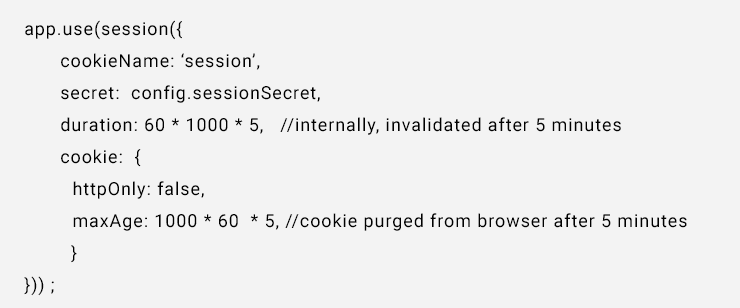

This issue can be moderated by keeping an inner expiration value within the session cookie.
Another problem with Express is this that the Csurf plugin is omitted from GET, HEAD, and OPTIONS methods. Csurf plugin protects web application from cross-site request forgery (CSRF). That is, an application with GET routes will not be protected from CSRF attacks.
That means the below code and the resulting app is vulnerable to CRSF because of the GET part.
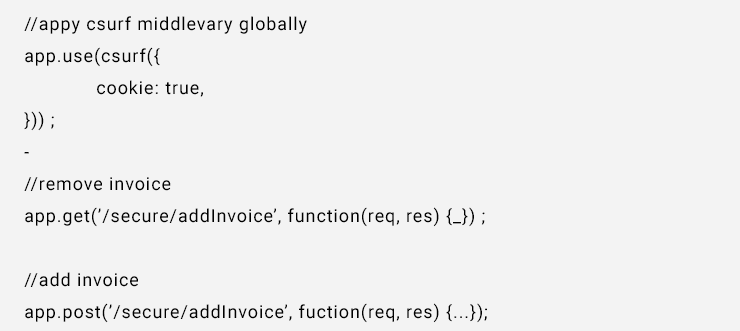

To mitigate this, developers should do one of the following:
- Change the /secure/remove Invoice route to use the POST method
- Remove GET from the ignore Methods option
- Apply the Csurf middleware inline to each route requiring protection rather than globally with use()
4. Angular
Angular has inherent Strict Contextual Escaping service ($sce) by default. This service secure Angular from malicious HTML tags (e.g., <script>, etc.), attributes (e.g., onmouseover, onerror, etc.), and URI protocols (e.g., javascript) from data rendered as HTML with the ng-bind-html directive.
The problem is Strict Contextual Escaping service ($sce) can turned off by sceProvider.enabled() method globally while $sce.trustAs methods turn it off per-instance. In short, Angular is quite vulnerable to cross-site scripting (XSS) attacks when binding insecure data as HTML.
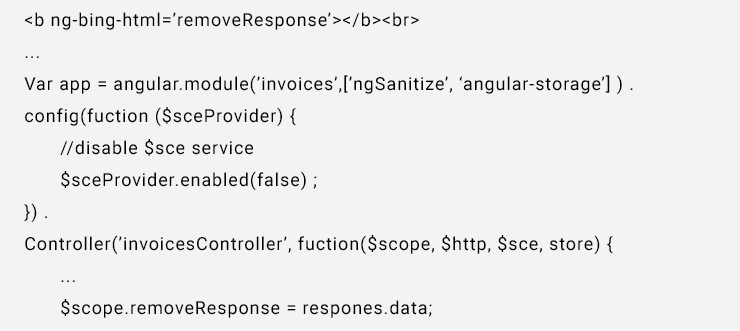

The easiest method around this vulnerabilities is to enable $sce service for untrusted bound to the ng-bind-html directive. Removing the $sceProvider.enabled(false) method from the excerpt above means the malicious onerror attribute will be sanitized appropriately.
Another security risk with Angular and thus MEAN stack applications is expression injection. An attacker can enter a curly bracket to Angular template to modify expressions. Aforementioned functions do not take in account expression injection using curly brackets.
To mitigate the risk, sanitize curly brackets from insecure input or by prevent the input from being written inside an Angular template by reducing the scope of the ng-app directive.
Conclusion
MEAN stack development is the epitome of DevOps that forbids insecure development practices. Besides, this approach entails sufficient controls to make sure that security is an integral part of every stage of development.
Why You Should Use MEAN stack for Real-time App Development?


MEAN stack lets you create real-time websites with push capability and give developers a tool for working in the non-blocking, event-driven I/O paradigm. Node.js shines in real-time web applications by employing push technology over web sockets.
Before MEAN came in, the web was living in a stateless request-response paradigm. MEAN stack brought us real-time web applications with two-way connections, where both the client and server can initiate communication, allowing them to exchange data freely.
This paradigm is quite revolutionary considering traditionally only client used to initiate communication.
As a result, MEAN forms the technology stack of various big enterprises.
It remains lightweight, efficient in the face of data-intensive real-time applications
MEAN stack certainly shines in building fast, scalable network applications, as it’s capable of handling a huge number of simultaneous connections with high throughput, which equates to high scalability. Unlike traditional web-serving techniques where each connection (request) spawns a new thread, taking up system RAM and eventually maxing-out at the amount of RAM available, MEAN stack development operates on a single-thread, using non-blocking I/O calls, allowing it to support tens of thousands of concurrent connections held in the event loop.


Suppose we are developing a real-time chat app. It uses traditional web-serving techniques and, consequently, for each new conversation, the program creates a new thread. Let’s say each thread occupies 2MB of RAM and the system has 8GB of RAM installed. The RAM will max out at 4000 concurrent conversations. If you have managed chat support center, then you know 4000 conversations at a time aren’t surprising.
In contrast, a MEAN stack based rea-time chat app can virtually, achieve scalability levels of over 1M concurrent conversation on a single thread in the same amount of RAM. Of course, even the largest of support centers don’t process this many requests at a time.
It is used in production by large companies
Companies such as PayPal, Uber, Netflix Walmart, Yahoo, etc. rely on MEAN stack development for a large chunk of their application portfolio. In fact, at PayPal, they rebuilt one of their Java and Spring based applications using Node and it found that the node application was built:
- Twice as fast with fewer people
- 33% fewer lines of code
- 40% fewer files
- 2x requests/second
- 35% faster response time
It has non-blocking or asynchronous nature
Imagine you go to a restaurant and a waiter comes to your table to take your order and gives it to the kitchen. Then he moves on to serve another table while the chef is preparing your meal and thus can serve many different tables. Diners don’t have to wait for the chef to cook one meal before they serve another table. This is what we call non-blocking or asynchronous architecture.
This is how node applications work: the waiter is like a thread allocated to handle a request. A single thread is used to handle multiple requests.


In contrast to non-blocking or asynchronous architecture, we have blocking or synchronous architecture. Imagine you go to another restaurant, and in this restaurant, a waiter is allocated to you. They take your order and give it to the kitchen now they are sitting in the kitchen waiting for the chef to prepare your meal. At this time, the waiter is not doing anything else. He is not going to take an order from another table until your meal is ready. This is what we call blocking or synchronous architecture and that’s how applications built with frameworks like asp.net or Rails work out of the box.
In Rail, when we receive a request on the server, a thread is allocated to handle that request. As a part of handling that requests, it is likely that we’re going to query a database and sometimes it may take a little while until the result is ready.


When the database is executing the query that thread is sitting there waiting; it can’t be used to serve another client and we need a new thread to serve another client.
It can serve thousands of concurrent clients
In case of real time applications, we have a large number of concurrent clients. At some point, we’re going to runout of threads to serve these clients and new clients have to wait until new threads are available.


With this kind of architecture, we are not utilizing our resources efficiently. This is the problem with blocking or synchronous architecture and that shows applications built with frameworks like asp.net can’t work in real-time due to their blocking nature.
Therefore, MEAN stack development is a natural choice while developing real-time applications due to its non-blocking nature. The application has a single thread to handle all requests when a request arrives, that single thread is used to handle that request.
If we need to query a database, our thread doesn’t have to wait for the database to return the data. While the database is executing our query, that thread will be used to serve another client. When the database prepares the result, it puts a message in what we call an event queue.


Node is continuously monitoring this queue in the background when it finds an event in this queue, it will take it out and process it. This kind of architecture makes MEAN stack ideal for building applications that include a lot of disk or network access.
We can serve more clients without the need to throw in more hardware and that’s why MEAN applications are highly scalable.
It has the best database to store JSON documents
MongoDB lets you develop faster, deploy easier and scale bigger. Real-time applications are more networked, social and interactive than ever. This is driving new requirements to support Big Data, fast feature development and flexible deployment strategies.
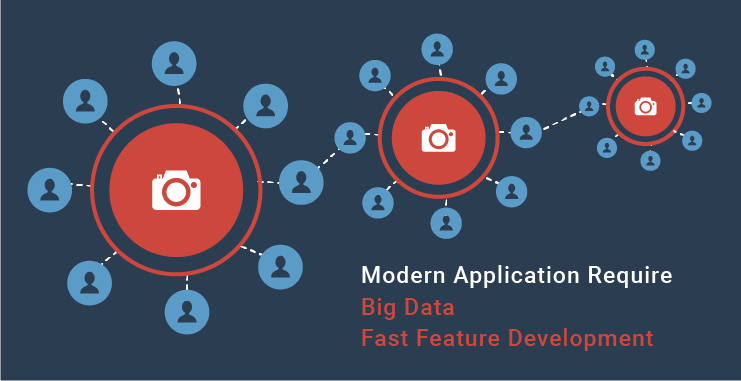

Real-time applications require storing more and more data and, more so over, accessing it at higher and higher rates. If your database runs on a single server you will reach a scaling limit. MongoDB scales by adding more servers; you can add more capacity whenever you want.
Modeling data as documents is simpler and allows schemas to evolve effortlessly without duplication. MongoDB works with commodity servers and elastic virtualized environments, saving you money and headaches.
It is not a bloated framework
MEAN stack does not come with the bells and whistles of a full stack framework. You can’t compare MEAN to Python Django, Python flask or Ruby on Rails. It’s a web-server technology that you can then use a bunch of different frameworks that exist. If you don’t need that stuff and you just want a bare-bones Web API, Node.js has been around a little bit longer and has a larger community. If you are not comfortable with bare-bones web APIs, you can go for Express.js, which is again a part of MEAN stack.
Depending on how slim you need your server-side API of you real-time applications to be, MEAN can be as slim as you need it to be.
The future is lean; we don’t want bloated full stack frameworks because bloated full stack frameworks are slow and they’re not built with the modern-day client-side library unlike MEAN. You need your server to be lean and efficient and it needs to be serving JSON data. So that these newer client-side libraries can then take it and build your UI from it.
It’s the Future
JavaScript, now on the front, is handling routing and everything else. You need a lean MEAN server-side setup and the best option out there if I compare it to some of these other stacks that have been around the block for quite some time. Ruby on Rails is way too bloated compared to a server-side language and it’s blocking type.
The future of web development I think rests more with MEAN stack and it does with any of the other older technology stacks like LAMP.
How Will MEAN Stack Development Add Value to Your Business?



MEAN stack garners interest of many technology firms that have existing investment into JavaScript realm whether in the form of software infrastructure or human resources. In addition, SMEs, in various industry verticals with little to no investment in web technologies, are looking at MEAN stack as the web development stack to replace their existing, hard-to-maintain apps in LAMP stack. After all, MEAN stack is everything businesses have been asking in a development stack. Isomorphic coding makes way for seamless interoperability between the two ends, lower utilization of human resources, re-usability of software components, cost-reduction and rapid cloud deployment of business apps.
Further, MEAN Stack is JavaScript, front and backend, which means a JavaScript developer can switch between client and server side of a business application without much fuss. No doubt, many businesses are looking at MEAN Stack development to build fresh business apps or replace existing ones. It brings a number of business benefits.
It Leverages on Existing Resources and Infrastructure
As JavaScript isn’t an entirely new language like Swift and Kotlin, chances are your organization will have an existing pool of JavaScript developers on whom you can leverage on. Most of the web developers are JavaScript developers by default. Even if you have to hire fresh resource, hiring web developers is easier than hiring .NET, PHP, or Java developers. They, also, cost lesser.
Since MEAN Stack is JavaScript at both the ends, a developer can easily switch between frontend and backend part of the development for a greater integration amidst the software sides. With no assigned roles, developers will work towards project completion rather than fulfilling their roles.
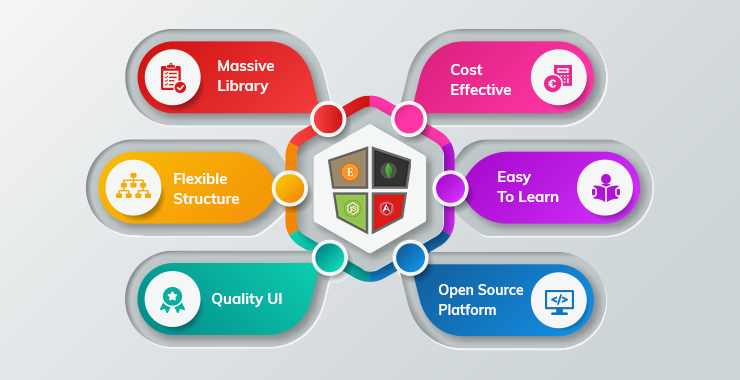

MEAN Stack is amalgamation of cross-platform technologies: MongoDB, Express.js, Angular, and Node.js and is thus cross-platform itself. The resulting code is platform independent. You don’t need specific hardware to run it and your existing IT infrastructure will work quite fine.
All in all, developing in MEAN stack doesn’t require you to make any additional investment. In most cases, your existing resources and infrastructure will do just fine.
It will Deliver the Ultimate User Experience
In MEAN stack app development, same set of developers develop frontend and backend. While in traditional web development where everything from frontend to database needs separate development teams to collaborate at various level. This often leaves too many gaps to fill at the end of each development cycle.
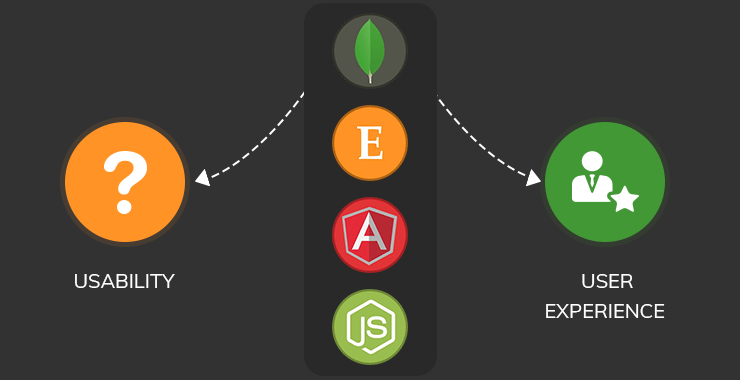

When the same developers create both side of the web application, those sides can communicate better; making way for tighter integration between the client and server side, which directly translates to top-notch user experience without too many caveats.
MEAN stack indeed adds value to your business by allowing you to develop advance business applications, which were previously were too complicated to implement or, even, impossible.
MEAN Stack Apps take Faster Time to Market
Web applications developed in MEAN stack have codebase written entirely in JavaScript. In fact, the isomorphic code functionality lets developer use the same set of JavaScript code between the components of MEAN stack. A function written for Node.js can very well be pasted into Express.js with little or no changes for the same results.


As the same team handles every part of the development from server configurations to database utilization, resulting business apps are well integrated between the software components. Even when there are voids between the components, any person of the development team, to save time, can fill it without having to collaborate with a member of other team. The same goes when developers are debugging the application before the first build.
Since the development can monitored closely in case of MEAN application, the resulting business apps tend to take far less time to market, which is exactly what businesses are looking for nowadays.
They are Easy to Maintain and Add Features to
Ask any scrum master, web development, with so many technologies involved, is a hard nut to crack when going all-out agile. Your MVP might take forever to reach the hands of your users and when it does, it might not deliver the business value you expected. At this point, businesses either abandon the app altogether or end up with weird user stories tied to strange personas, which give birth to unwanted features that your users will seldom use.
When such distorted business apps enter the market, they are costly to maintain as businesses have to keep subset of all the teams involved in the development during its lifetime in order to keep it usable or when adding unwanted features.


Applications developed in MEAN Stack addresses many complications associated with traditional web technologies by bringing every part of development into JavaScript realm. Since a single JavaScript developer can maintain your app, you don’t have to run whole lot of maintenance teams and, thus, you can maintain your business apps at the fraction of cost.
When adding new features, you just have to bring a few more JavaScript developers, which again need less resources than traditional web development. In traditional web apps to add new features, developers from various technology teams have to collaborate at various level that delays updates to your business apps.
MEAN Stack = High Performance Business Applications
In today’s date and time, businesses want their apps as high performing as any other consumer-centric app in the market. SMEs are already making strides into the world of PWAs, which are as good as mobile apps when running in a web browser environment.
For businesses looking to develop web apps that look and feel like mobile apps, MEAN is the best solution. Unlike traditional web technologies, MEAN utilizes single-page applications (SPAs).
PWAs built in MEAN stack work offline and don’t have to be constantly updated for each server request. When needed to be update; PWAs, in real-time, only update a part of the UI rather than the entire webpage unlike traditional web apps that reload after each click or tap.
Resulting real-time applications are turning out to be the gold standard of web development in the business world.
Final Thoughts
With so many benefits MEAN stack and JavaScript bring, including the cost benefits, it’s high time businesses must adopt to these gold standards of web development if they are looking for highest performance to cost ratio. Not to mention, they can finally replace their legacy web apps with those coded in JavaScript under MEAN stack. They can do so without the need of additional resources and investment in IT infrastructure.
Even if they don’t have the infrastructure in place, MEAN stack apps are easy to deploy on cloud. For additional resources, they always hire a cloud team to collaborate with their in house team.
For example, TOPS has a team of 30+ MEAN stack developers, who are ready to collaborate with you in any existing or new MEAN stack project, business apps or consumer apps.
Read More Articles:
- How Does MERN Stack Development Help In Building Web And Mobile Applications?
- An Ultimate Guide To Hiring The Dedicated MEAN Stack Developers
- Top Skills to Identify Before Hiring the Best Full Stack Developer
- Why MERN Stack Development Is A Go-To Stack For Developers?
LAMP vs. MEAN Stack: Choosing the Right Fit for your Project


E-commerce platforms like Amazon, Walmart, eBay, Alibaba, etc. provide the best user experience and that’s the reason they are always on top of trends and can respond to millions of requests within seconds.
It is all because they have used the best business model which is supported by influential technology. Have you ever thought how huge such kind of system would be? What it would take to reach such great heights?
Let’s figure it out…
To develop such a web-driven application, it should be supported by technology like Apache Tomcat as the web server and PHP and J2EE as the development framework. For years, LAMP is serving as the go-to technology as it is involved in Linux, Apache, MySQL and PHP, Perl, and Python.
Although LAMP is a good technology to deal with, it is a conventional approach to handle large database web applications. So, this technology is replaced with MEAN (MongoDB, ExpressJS, AngularJS, and NodeJS) to provide faster and more efficient web development due to JavaScript compatibility.
Since it works on the REST API, web apps can be developed by multiple front ends and the same back end; hence reduces the cost of developing the back end. Moreover, you can replace Angular.js with any framework that suits best the system.
Why MEAN is the Best For Your Enterprise Compared to LAMP?
-
MongoDB vs. MySQL:
MongoDB is considered a modern NoSQL database with a number of features and compatibilities. The strength of MongoDB lies in the relational databases compared to MySQL. When a relational database is used in MySQL, it feels like data is pushed into the table forcefully.
The system works perfectly when a single entry fits into every single format but fails badly when it doesn’t happen. On the other hand, MongoDB offers a document structure that is more flexible. So, if you wish to add new fields then simply add the field to the form, roll it up with the rest of the Data in the JSON document, and put it into the MongoDB collection.
This is great for the data dealing with dynamic data which is difficult to constrain in table form.
-
Makes your UX better with front-end
One of the major reasons to shift from LAMP to MEAN is to migrate from server-side page generation to client-side single-page applications. In MEAN, Express.js works on the REST structure and handles server-side routing and Angular.js handles client-side views.
The web-page presentation and control flow task in LAMP which was handled by PHP, Perl, or Python is taken care of by Expres.js and Angular in MEAN. Additionally, Angular.js also handles the data presentation of an application. Hence, this shift is from synchronous to asynchronous processes and page-centric views to component-oriented views of an application.
Moreover, being back with an excellent JavaScript front-end framework, the web app runs efficiently, making the UX smoother. With all such parameters in the mean stack, it enables the web application to run on desktops, laptops, mobile phones, tablets, etc.
-
The Code
MEAN makes use of Express.js and Angular.js to drive the web page presentation and control flow. Express.js serves as a controller layer, controlling application flow and organizing data for Angular.js, which handles data presentation. The importance of this is, it has simplified back-end architecture.
If you write the code for Node and decide to place it in Angular, you can do it with ease. This flexibility makes MEAN-based apps significantly easier. You can have the added benefit of having an entirely single language and don’t have to look for additional developers like a PHP expert, JavaScript experts, or front-end or back-end specialists – just a front-end javascript developer to trace all the way down the stack without having to learn another programming language.
-
Node.js simplifies the server layer
Navigating various layers of the LAMP stack is like dancing on many hats; going through the various config files with different syntaxes. This sounds a bit clumsy. But, when it comes to MEAN, it simplifies this with the help of Node.js.
Sprinkle in some JavaScript whether you want to change how your app routes requests or want to change the logic used to answer queries you want to rewrite URLs or construct an odd mapping and let Node.js do the rest of the work.
The MEAN stack in combination with Node.js keeps everything in one place and one language. You don’t have to read the pages of PHP, generate different config files, etc as in LAMP. Having everything in one place reduces the chances of errors and confusion between multiple layers.
To be precise…..
LAMP stack has surely become a conventional approach but it holds good efficiency in the market over the years as many CMS still rely on LAMP. However, MEAN Stack becoming a new player provides new and innovative ways to cut the grounds.
MEAN web development has its own list of benefits to offer for flexible web development, especially for an organization that is looking to move its focus from LAMP to an advanced Mean stack technology.
Looking to develop your next big project in MEAN? We are just a call away!! Let’s connect.




